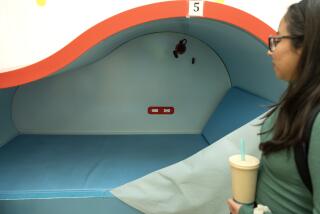Enthusiasm About Math Multiplies
- Share via
They come from one of the Los Angeles area’s poorest neighborhoods--and from schools with some of the state’s lowest test scores.
But Lynwood elementary school pupils measured up just fine, thank you, when they hiked across the sprawling UCLA campus Tuesday on a hunt for some of the Westwood campus’ most unusual treasures.
They were on the Mathematics Trail, busily calculating the size of the university’s most eye-catching fountain, estimating the height of its oldest classroom steps and studying the dazzling geometry of its trademark brick buildings.
The two-hour outing is a highlight of the university’s Young Mathematicians project--a summertime program that for seven years has tried to boost the math skills of youngsters in some of Los Angeles County’s poorest-performing schools.
The idea is to make math appealing to children by making it real. And fun.
“This is a lot more interesting than just learning about it from a book,” agreed 10-year-old Yoci Solis as she carefully recorded her calculations about the amount of rise in the steps at the east entrance to Kinsey Hall, one of UCLA’s four original classroom buildings.
The Mathematics Trail was devised by Susie Hakaansson, director of the Young Mathematicians program. She got the idea after seeing a similar project at a 1992 educators’ conference in Quebec.
“I learned so much about the history of Quebec City taking it. Just seeing the mathematics around me everywhere in the outdoors clicked. I thought about UCLA’s mosaics, our tile work, our old buildings,” Hakaansson said.
“When I got back here, I started seeing mathematics coming alive as I walked around. Here was a way to make math relevant,” she added.
It was coming alive Tuesday for 8-year-old Walter Cabrera as he stepped back and studied the circular “inverted fountain” between the physics and geology buildings. Its unusual design sends water cascading into a large hole in its center.
Walter estimated that the fountain, whose water flows at 10,000 gallons per minute, had a diameter of 150 paces. When he stoically marched around it, he discovered it was actually 130 paces.
At Kinsey Hall students translated the Roman numerals engraved above a doorway into Arabic numbers. Outside Haines Hall they studied the Romanesque animal carvings around the eastern entryway.
They lingered in front of Royce Hall, studying the symmetry of its famed twin towers and hunting for the slight differences in the design of each. They examined the shapes of glass panes in the huge light fixtures in the hall’s portico.
Kaila Mallard, 11, recorded in her Mathematics Trail journal that the glass panels were wider at the top and sides than elsewhere. Counting the edges of the fixtures’ bottoms, she decided they were hexagons.
Nearby, at the top of the famed Janss Steps, students estimated the number of steps before marching down them and counting.
Maria Argueta, 9, guessed 81. Sylvester Navarrete, 9, was certain the number was 170. Nine-year-old Raymond Calderon estimated 82. Viridiana Tizcareno, 10, wrote down 84 in her journal.
Although the footstep-count varied among the laughing, shouting children as they reached the bottom, the average tally was 87.
That kind of math exercise--the physical kind--is something teachers everywhere can use, said professor Jeannie Oakes, an expert on urban education who oversees the Young Mathematicians project and companion Young Readers and Young Writers summer programs.
The Mathematics Trail “takes math out of the area of abstraction, of paper and pencil. And it lets Lynwood kids know that UCLA is a place they can aspire to go to,” Oakes said.
This summer’s three-week math program includes three hours of daily classroom instruction in Lynwood from teachers trained and paid by UCLA. The Lynwood school district pays the university $250 per child to cover the costs.
Barbara Johnson, director of curriculum and instruction for Lynwood, said it’s money well spent. Although the district’s math scores (reported in today’s editions of The Times) show its students performing at or near the bottom in Los Angeles County, other test results indicate that math scores rose after Lynwood’s premier Young Mathematicians involvement last summer, Johnson said.
The program certainly has added up for Yoci Solis.
“I’ve decided,” the fifth-grader announced at the end of the Mathematics Trail, “that I want to be a math teacher when I grow up.”
More to Read
Sign up for Essential California
The most important California stories and recommendations in your inbox every morning.
You may occasionally receive promotional content from the Los Angeles Times.











